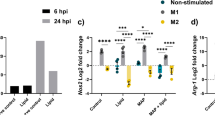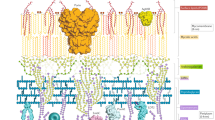Abstract
Restricting the availability of iron is an important strategy for defense against bacterial infection1,2,3. Mycobacterium tuberculosis survives within the phagosomes of macrophages; consequently, iron acquisition is particularly difficult for M. tuberculosis, because the phagosomal membrane is an additional barrier for its iron access4,5. However, little is known about the iron transport and acquisition pathways adapted by this microbe in vivo6. Extracellular iron sources are usually mobilized by hydrophilic siderophores7,8. Here, we describe direct evidence that mycobactins, the lipophilic siderophores of mycobacteria, efficiently extract intracellular macrophage iron. The metal-free siderophore is diffusely associated with the macrophage membrane, ready for iron chelation. Notably, the mycobactin-metal complex accumulates with high selectivity in macrophage lipid droplets, intracellular domains for lipid storage and sorting9,10. In our experiments, these mycobactin-targeted lipid droplets were found in direct contact with phagosomes, poised for iron delivery. The existence of this previously undescribed iron acquisition pathway indicates that mycobacteria have taken advantage of endogenous macrophage mechanisms for iron mobilization and lipid sorting for iron acquisition during infection. The pathway could represent a new target for the control of mycobacterial infection.
This is a preview of subscription content, access via your institution
Access options
Subscribe to this journal
Receive 12 print issues and online access
$259.00 per year
only $21.58 per issue
Buy this article
- Purchase on Springer Link
- Instant access to full article PDF
Prices may be subject to local taxes which are calculated during checkout




Similar content being viewed by others
References
Flo, T.H. et al. Lipocalin 2 mediates an innate immune response to bacterial infection by sequestrating iron. Nature 432, 917–921 (2004).
Ferreras, J.A., Ryu, J.S., Lello, F.D., Tan, D.S. & Quadri, L.E.N. Small-molecule inhibition of siderophore biosynthesis in Mycobacterium tuberculosis and Yersinia pestis. Nat. Chem. Bio. 1, 29–32 (2005).
Fluckinger, M., Hass, H., Merschak, P., Glasgow, B.J. & Redl, B. Human tear lipocalin exhibits antimicrobial activity by scavenging microbial siderophores. Antimicrob. Agents Chemother. 48, 3367–3372 (2004).
Pieters, J. Entry and survival of pathogenic mycobacteria in macrophages. Microbes Infect. 3, 249–255 (2001).
Rhoades, E.R. & Ullrich, H.J. How to establish a lasting relationship with your host: lessons learned from Mycobacterium spp. Immunol. Cell Biol. 78, 301–310 (2000).
Schaible, U.E. & Kaufmann, S.H.E. Iron and microbial infection. Nat. Rev. Microbiol. 2, 946–953 (2004).
Albrecht-Gary, A.M. & Crumbliss, A.L. Coordination chemistry of siderophores: thermodynamics and kinetics of iron chelation and release. Met. Ions Biol. Syst. 35, 239–327 (1998).
Ratledge, C. & Dover, L.G. Iron metabolism in pathogenic bacteria. Annu. Rev. Microbiol. 54, 881–941 (2000).
Melo, R.C., D'Avila, H., Fabrino, D.L., Almeida, P.E. & Bozza, P.T. Macrophage lipid body induction by Chagas disease in vivo: putative intracellular domains for eicosanoid formation during infection. Tissue Cell 35, 59–67 (2003).
Yu, W. et al. Co-compartmentalization of MAP kinases and cytosolic phospholipase A(2) at cytoplasmic arachidonate-rich lipid bodies. Am. J. Pathol. 152, 759–769 (1998).
Burke, B. & Lewis, C.E. The Macrophage (Oxford University Press, Oxford, UK, 2002).
Torti, S.V. et al. The molecular cloning and characterization of murine ferritin heavy chain, a tumor necrosis factor-inducible gene. J. Biol. Chem. 263, 12638–12644 (1988).
Byrd, T.F. & Horwitz, M.A. Regulation of transferrin receptor expression and ferritin content in human mononuclear phagocytes. Coordinate upregulation by iron transferrin and downregulation by interferon gamma. J. Clin. Invest. 91, 969–976 (1993).
Weiss, G., Wachter, H. & Fuchs, D. Linkage of cell-mediated immunity to iron metabolism. Immunol. Today 16, 495–500 (1995).
Vergne, A.F., Walz, A.J. & Miller, M.J. Iron chelators from mycobacteria (1954–1999) and potential therapeutic applications. Nat. Prod. Rep. 17, 99–116 (2000).
Olakanmi, O., Schlesinger, L.S., Ahmed, A. & Britigan, B.E. Intraphagosomal Mycobacterium tuberculosis acquires iron from both extracellular transferrin and intracellular iron pools. Impact of interferon-gamma and hemochromatosis. J. Biol. Chem. 277, 49727–49734 (2002).
Sun, H., Li, H.Y. & Sadler, P.J. Transferrin as a metal ion mediator. Chem. Rev. 99, 2817–2842 (1999).
Fadeev, E.A., Luo, M. & Groves, J.T. Synthesis, structure, and molecular dynamics of gallium complexes of schizokinen and the amphiphilic siderophore acinetoferrin. J. Am. Chem. Soc. 126, 12065–12075 (2004).
Murphy, D.J. The biogenesis and functions of lipid bodies in animals, plants and microorganisms. Prog. Lipid Res. 40, 325–438 (2001).
Dvorak, A.M. et al. Lipid bodies: cytoplasmic organelles important to arachidonate metabolism in macrophages and mast cells. J. Immunol. 131, 2965–2976 (1983).
De Voss, J.J. et al. The salicylate-derived mycobactin siderophores of Mycobacterium tuberculosis are essential for growth in macrophages. Proc. Natl. Acad. Sci. USA 97, 1252–1257 (2000).
Xu, G., Martinez, J.S., Groves, J.T. & Butler, A. Membrane affinity of the amphiphilic marinobactin siderophores. J. Am. Chem. Soc. 124, 13408–13415 (2002).
Luo, M., Fadeev, E.A. & Groves, J.T. Membrane dynamics of the amiphiphilic siderophore, acinetoferrin. J. Am. Chem. Soc. 127, 1726–1736 (2005).
Moody, D.B. et al. T cell activation by lipopeptide antigens. Science 303, 527–531 (2004).
Testa, U. et al. Iron up-modulates the expression of transferrin receptors during monocyte-macrophage maturation. J. Biol. Chem. 264, 13181–13187 (1989).
Mulero, V. & Brock, J.H. Regulation of iron metabolism in murine J774 macrophages: role of nitric oxide-dependent and independent pathways following activation with gamma interferon and lipopolysaccharide. Blood 94, 2383–2389 (1999).
Crosa, J.H. & Walsh, C.T. Genetics and assembly line enzymology of siderophore biosynthesis in bacteria. Microbiol. Mol. Biol. Rev. 66, 223–249 (2002).
De Voss, J.J., Rutter, K., Schroeder, B.G. & Barry, C.E. Iron acquisition and metabolism by mycobacteria. J. Bacteriol. 181, 4443–4451 (1999).
Ratledge, C. Iron, mycobacteria and tuberculosis. Tuberculosis (Edinb.) 84, 110–130 (2004).
Olakanmi, O., Britigan, B.E. & Schlesinger, L.S. Gallium disrupts iron metabolism of mycobacteria residing within human macrophages. Infect. Immun. 68, 5619–5627 (2000).
Acknowledgements
The authors thank M. Marlow for providing facilities and technical assistance with cell cultures, J. Goodhouse for fluorescent confocal microscopy and F. Morel and B. Ward for iron-labeling experiments. Support of this work by the US National Science Foundation (CHE-0221978) through the Environmental Molecular Science Institute (CEBIC) at Princeton University is gratefully acknowledged.
Author information
Authors and Affiliations
Corresponding author
Ethics declarations
Competing interests
The authors declare no competing financial interests.
Supplementary information
Rights and permissions
About this article
Cite this article
Luo, M., Fadeev, E. & Groves, J. Mycobactin-mediated iron acquisition within macrophages. Nat Chem Biol 1, 149–153 (2005). https://doi.org/10.1038/nchembio717
Received:
Accepted:
Published:
Issue Date:
DOI: https://doi.org/10.1038/nchembio717
This article is cited by
-
Macrophage targeted iron oxide nanodecoys augment innate immunological and drug killings for more effective Mycobacterium Tuberculosis clearance
Journal of Nanobiotechnology (2023)
-
Iron limitation in M. tuberculosis has broad impact on central carbon metabolism
Communications Biology (2022)
-
Mycobacterium abscessus pathogenesis identified by phenogenomic analyses
Nature Microbiology (2022)
-
Host glyceraldehyde-3-phosphate dehydrogenase-mediated iron acquisition is hijacked by intraphagosomal Mycobacterium tuberculosis
Cellular and Molecular Life Sciences (2022)
-
Complete genome sequence of Mycobacterium Mya-zh01, an endophytic bacterium, promotes plant growth and seed germination isolated from flower stalk of Doritaenopsis
Archives of Microbiology (2020)



